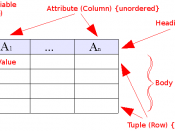Database Use Paper
Relational databases can be tracked back to the IBM era in the 1960's and 70's. Thanks to a man named Ted Codd who was a researcher for IBM in 1970, we can now store data in a relational database. The days of storing and indexing files manually are virtually over in the database world. Oracle Corporation uses relational database management systems (RDBMS) to maintain all the data within the support organization.
Various data items can be grouped according to obvious relationships, such as the relationship of Employee Name to Employee ID. This relational database model gives Oracle a great deal of flexibility to describe the relationships between the data elements. Oracle follows Dr. Codd's 12 basic rules for a relational database model within worldwide support:
1. Information rule-All information in a relational database (including table and column names) is represented explicitly as values in tables.
2. Guaranteed access-Every value in a relational database is guaranteed to be accessible by using a combination of the table name, primary key value, and column name.
3. Systematic null value support-The DBMS provides systematic support for the treatment of null values (unknown or inapplicable data), distinct from default values, and independent of any domain.
4. Active, online relational catalog-The description of the database and its contents is represented at the logical level as tables and can therefore be queried using the database language.
5. Comprehensive data sublanguage-At least one supported language must have a well-defined syntax and be comprehensive. It must support data definition, manipulation, integrity rules, authorization, and transactions.
6. View updating rule-All views that are theoretically updatable can be updated through the system.
7. Set-level insertion, update, and deletion-The DBMS supports not only set-level retrievals but also set-level inserts, updates, and deletes.
8. Physical data independence-Application programs and ad...



Good Paper!
Good paper, little passive words, few mistakes. APA format is needed in citations.
3 out of 3 people found this comment useful.